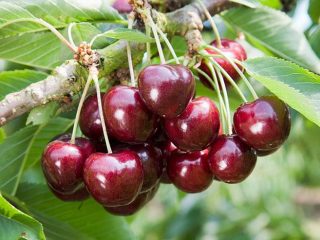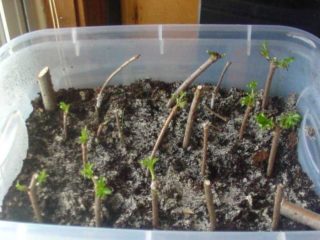Content
Cherries should be watered abundantly only during 1 season, immediately after rooting. Seedlings need large volumes of water (2-3 times a month) and fertilizing, especially in dry weather. Starting from season 2, the frequency is reduced to 1-2 times a month, with the exception of the hot season. Mature bushes aged 5 years and older do not need additional watering - they usually have enough rainfall. But periodically it is worth checking the soil with your finger - drying out of the soil is unacceptable.
Do I need to water cherries?
Cherry is a drought-resistant plant, but it still needs additional (artificial) watering. It is especially important to give water in the following cases:
- During the first year of life, seedlings need watering 1.5-2 buckets every 2 weeks.
- In summer, in dry, hot weather. At this time, water is given approximately 2 times a month (for adult bushes) and weekly for one-year-old seedlings.
- At the stage of fruit formation, the volume of liquid is increased only if necessary (the soil is very dry at a depth of 5-6 cm).
- In September: if you give the plant plenty of water, it will survive winter frosts much better.
Judging by the experience of summer residents, the older the bush, the less watering it needs. If young seedlings are moistened regularly (2-3 times a month, and in hot weather weekly and sometimes even more often), then bushes over 3 years old should be moistened only when the soil dries.

Mature cherries (5-10 years and older) do not need watering at all, except during periods of prolonged drought.
How often should you water cherries?
The frequency and volume of watering depends on both the season and the age of the tree. For example, watering cherries after planting in the spring should be done weekly or 2-3 times a month. Starting from the 2nd season, seedlings are given water only when the soil dries out. The main criterion remains soil moisture. If at a depth of 5-6 cm (the size of a little finger) it remains noticeably wet, then the volume of water is sufficient.
If the soil is too moist and dirt sticks to your finger, watering should be stopped immediately and the “measurement” taken again after a week. Overwatering has a detrimental effect on the plant - it often causes rotting of the cherry roots. Therefore, in general, it is better to regulate the volume based on actual indicators.
How often to water cherries in spring
The main watering in spring is carried out in warm weather (April-May). Moreover, young, newly rooted seedlings should be watered especially abundantly - at least once a week. This cherry watering regime continues in spring and summer. In all cases, use the same volume - 15-20 liters of water (1.5-2 buckets per 1 cherry).
From the second year of life onwards, there is no longer any special need to water the cherry tree in the spring.Now you can give 2 liters of water only in the event of warm days in April and May, when the surface and squat layer of soil have become almost completely dry. Frequency – once every 2 weeks or less (if it rains).
How often to water cherries in summer
During the summer season, special attention is paid to watering cherries. First year seedlings should be given 1-2 buckets 2 times a month, except in rainy weather. If the soil has become too wet, you can skip 1 week and then navigate according to the situation.
If there is a long drought or extreme heat for several days in a row, it is necessary to increase both the volume of watering and its frequency. Cherry seedlings aged 1 year are given 2 buckets, adult bushes over 3 years old - from 3 to 6 buckets of water. This watering regime continues 1-2 times a month. In rare cases, water is given even more often, weekly. But in general, a one-time supply of water, for example, on weekends, is quite sufficient.

Almost all varieties of cherries are highly drought-resistant, but if water is not given in the hot summer, the yield will decrease and the fruits will become small
How often should you water cherries in the fall?
Despite the fact that the cherry tree is preparing for a dormant period in the fall, it still requires abundant watering - about the same as in the summer. The fact is that if the tree is well watered before frost, it will survive the winter cold much better. This is especially true for regions with extremely cold winters.
The watering mode is as follows:
- In warm weather (September and Indian summer), water 2-3 times a month so that the soil remains moderately moist at a depth of 5-6 cm.
- The last abundant watering is given immediately after the tree has completely shed its leaves.
If this is not possible, you can organize watering of the cherries in September on a daily basis for a week. The volume of water in this case is 2 buckets per bush. Then the water supply should be completely stopped - the plant should have time to prepare for winter. At this moment, metabolic processes begin to slow down.
How to water cherries when planting
When planting, the seedling is watered with settled, fairly warm water (room temperature or higher). It is better to first keep it in the sun or indoors for at least a day. The volume for the first watering immediately after planting is about 2-3 buckets (20-30 l) per 1 seedling.
The sequence of actions is simple:
- Dig a hole of the required size and depth.
- Lay a fertile layer of soil.
- A cherry seedling is placed in the center.
- Sprinkle with earth.
- Water with 2 liters of pre-settled (for 12-24 hours) water.
At the same time, it is not necessary to immediately give nitrogen fertilizers or lime, since they can harm the root system of the plant. Therefore, you should water with plain water - without adding fertilizers.

The planting hole is immediately watered generously with 2-3 buckets of water.
How to water cherries correctly
It is better to use settled water for irrigation - for example, kept overnight, for several days, or rainwater stored in a container in the open air. It is also possible to use well water, but it must first be warmed to room temperature.
Watering methods are chosen depending on the age of the tree:
- Seedlings need special care. The best option is sprinkling irrigation (using a rotating sprayer). If there is no running water or other equipment nearby, you can get by with a watering can.
- Mature bushes aged 5-10 years and older can be watered in the traditional way - with water from buckets. However, the pressure should be of medium strength - water from the bucket is gradually poured onto the circle near the trunk, the liquid is absorbed, after which a new portion is given. The most convenient way to do this is with a watering can.
- If you have running water, you can also water with a hose. In this case, it is also necessary to regulate the pressure, and most importantly, to correctly determine the volume of water.
- Finally, the most advanced method is drip irrigation, when water is supplied directly to the roots through small droppers. But cherries are not capricious crops, so they do not feel any special need for such watering.
Is it possible to water cherries during flowering?
Watering cherries during flowering is mandatory. This period usually falls in the first half of May (and in the southern regions, the first flowers appear at the end of April). Therefore, you should not give too much water. Usually 3-5 buckets per 1 bush are enough, 2 times a month.
The only exceptions are those cases when already in May (and sometimes in April) there is hot, dry weather for a long time. The drought criterion is exactly the same - you need to check the top layer of soil 5-6 cm deep. If it has become almost dry, then you need to add 30-50 liters.
Advice from experienced gardeners
Experienced gardeners often do not adhere to a strict watering regime, but simply pay attention to precipitation, the condition of the soil and the bush itself. In addition, they use certain practical methods to avoid large losses of water. Therefore, you can pay attention to some practical advice from summer residents:
- Every spring and every autumn (before the onset of frost), the root circle must be mulched. To do this, add a layer of pine needles, sawdust, and peat up to 6-7 cm high. Mulch protects against rapid loss of moisture in the hot summer and from severe cooling of the soil in winter.
- When fertilizing, the soil must be moistened with 1-2 buckets of water - then minerals and organic substances will be much better absorbed by the roots.
- Mature bushes (5-10 years and older) practically do not require watering - you can give water only in extreme cases 2-3 times per season. If the region belongs to a zone of sufficient moisture, even this need not be done.
- Since seedlings of the first year of life need a lot of water, it is necessary to create a circular depression with a diameter of 50 cm and a depth of up to 20 cm. Then the water will remain in this “groove”, and the number of waterings can be reduced to 1-2 per month.

The presence of a small depression in the tree trunk prevents water loss, so the soil remains moist longer
Conclusion
Cherries need to be watered correctly. Any settled water at room temperature or slightly warmer (25-27 degrees) is suitable for this. Volumes are adjusted depending on soil conditions.In any case, it is worth remembering the rule: young seedlings like frequent and abundant watering, while mature bushes usually have enough natural rainfall.












